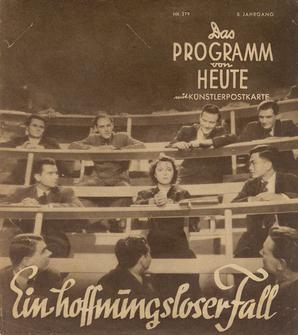Related Research Articles

Asta Sofie Amalie Nielsen was a Danish silent film actress who was one of the most popular leading ladies of the 1910s and one of the first international movie stars. Seventy of Nielsen's 74 films were made in Germany where she was known simply as Die Asta.

Peter Urban Bruun Gad was a Danish film director, stage actor, screenwriter, and author. He directed 40 films between 1910 and 1927. His wife Asta Nielsen starred in 30 of his films, also in his début film Afgrunden from 1910. They moved to Germany in 1911 where Gad worked with Paul Davidson until 1922.

Back Then is a 1943 German drama film directed by Rolf Hansen and starring Zarah Leander, Hans Stüwe, and Rossano Brazzi. The film's sets were designed by Walter Haag. It was made at the Babelsberg Studio, by Universum Film AG, Germany's largest film company. It was Leander's final film of the Nazi era, as she returned to Sweden shortly afterwards. This was a blow for the German film industry, as she was the most popular and highest-paid star. Leander's next film was not for another seven years, when she made a comeback in Gabriela (1950).

The Three Mannequins is a 1926 German silent film directed by Jaap Speyer and starring Hans Albers, Anton Pointner, and Paul Graetz. It was shot at the Terra Studios in Berlin. The film's sets were designed by the art director Hans Jacoby. It premiered at Berlin's Marmorhaus.
The White Roses is a 1916 German silent film directed by Urban Gad and starring Asta Nielsen, Ernst Hofmann, Max Landa and Fred Immler.
The False Asta Nielsen is a 1915 German silent film directed by Urban Gad and starring Asta Nielsen and Victor Arnold.
Zapata's Gang is a 1914 German comedic silent film directed by Urban Gad and starring Asta Nielsen and Fred Immler. It depicts the difficulties a crime film's actors face after being mistaken for actual robbers.
The Film Primadonna is a 1913 German silent film directed by Urban Gad and starring Asta Nielsen and Paul Otto.
Little Angel is a 1914 German silent comedy film directed by Urban Gad and starring Asta Nielsen, Max Landa and Fred Immler.
The Dance of Death is a 1912 German silent film directed by Urban Gad and starring Gad's wife Asta Nielsen. It was one of the first films made at the new Babelsberg Studio in Berlin.
Frontstairs and Backstairs is a 1915 German silent film directed by Urban Gad and starring Asta Nielsen and Paul Otto. It is based on the 1889 play Honour by Hermann Sudermann.
The Queen of the Stock Exchange is a 1918 German silent film directed by Edmund Edel and starring Asta Nielsen and Aruth Wartan.
Helmsman Holk is a 1920 German silent drama film directed by Rochus Gliese and Ludwig Wolff and starring Asta Nielsen,Theodor Loos and Paul Wegener.

A Hopeless Case is a 1939 German comedy film directed by Erich Engel and starring Jenny Jugo, Karl Ludwig Diehl and Hannes Stelzer.

Counterfeiters is a 1940 German crime film directed by Hermann Pfeiffer and starring Kirsten Heiberg, Rudolf Fernau and Karin Himboldt.

The Traitress is a 1911 German silent drama film directed by Urban Gad and starring Asta Nielsen, Max Obal, Robert Valberg and Emil Albes.
Friedrich Emil Albes was a German actor and film director of the silent era.
Jugend und Tollheit is a German silent film in three acts by Urban Gad from 1913, starring Gad's wife Asta Nielsen and Hans Mierendoff. It is one of the director's lost films.
Gipsy Blood is a 1911 German silent drama film directed and written by Urban Gad and starring Asta Nielsen, Georg Schrader, and Leo Peukert.
The Moth is a 1911 German silent drama film directed and written by Urban Gad. It was the second film that Asta Nielsen made in Germany. The film is considered lost.
References
- ↑ Kapczynski & Richardson p.47